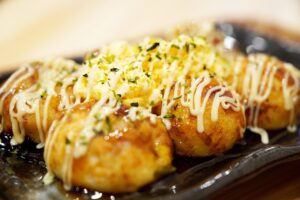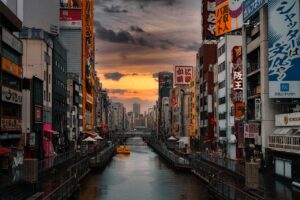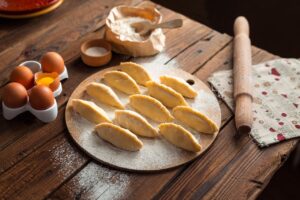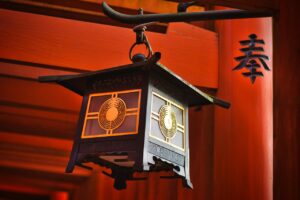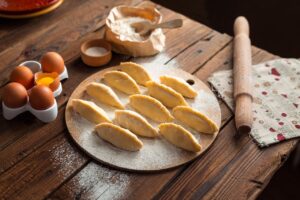Welcome to Dotonbori. If Osaka is the heart of Japan’s Kansai region, then Dotonbori is its wild, beating, neon-drenched pulse. It’s a place that doesn’t just stimulate the senses; it launches an all-out, joyful assault on them. The air, thick with the savory steam of a thousand kitchens, carries the scent of grilled meat, sweet sauces, and the unmistakable aroma of sizzling batter. Towering signs, sculpted into dragons, giant gyoza, and an enormous, mechanically-waving crab, compete for your attention, their vibrant lights painting streaks across the dark waters of the canal below. This is Osaka’s kitchen, its playground, its soul. And right in the middle of this glorious, Blade Runner-esque chaos stands a beacon for food lovers, a multi-story building guarded by a massive, crimson octopus with a headband, proudly clutching a takoyaki ball. This is the Dotonbori Konamon Museum, a shrine dedicated to Osaka’s most beloved culinary creations: konamon, the delicious world of flour-based foods.
But this isn’t your typical, behind-the-glass museum experience. It’s a living, breathing, and incredibly tasty institution where you don’t just learn about Osaka’s iconic street food—you roll up your sleeves and make it yourself. It offers a portal into the very essence of Osakan culture, which is famously defined by the principle of kuidaore—to eat until you drop. Here, food isn’t just sustenance; it’s an identity, a passion, and a way of life. Making your own takoyaki in the heart of Dotonbori is more than a cooking class; it’s a rite of passage, a delicious, hands-on pilgrimage into the city’s obsession with good food and good times. It’s about creating a memory that’s as tangible and warm as the perfectly crisp, gooey octopus ball you’ll soon be popping into your mouth.
After mastering the art of takoyaki at the museum, you can continue your culinary journey by sampling the Michelin-grade takoyaki at a legendary local shop.
The Konamon Calling: An Atmosphere You Can Taste

Entering the Dotonbori Konamon Museum feels like stepping straight into the heart of a lively food festival. On the ground floor, an active takoyaki stand buzzes with motion and sound. The rhythmic tapping of metal picks against cast-iron grills creates a steady, captivating beat that sets the tempo of Dotonbori. Skilled vendors, their hands moving swiftly, effortlessly flip dozens of takoyaki at once, their movements refined by years of experience into a kind of culinary martial art. The batter sizzling on the hot, oiled pans emits a constant hiss, while the sweet and savory aroma fills the air, inviting and rich. You can watch as they coat the finished balls in thick, dark takoyaki sauce and a lattice of creamy mayonnaise, then scatter them with a flurry of dancing bonito flakes. It’s a show—and you have a prime seat.
Yet the real enchantment for budding chefs awaits upstairs. As you climb the stairs, the atmosphere shifts from the lively bustle of a street stall to a bright, welcoming workshop. This is the B1 floor, the ‘Konamon Studio,’ where you get to become the creator. The space is clean and orderly, lined with rows of cooking stations, each outfitted with its own takoyaki grill. The energy here is different—charged with excited anticipation. You’ll find fellow visitors, families, and couples, all donning aprons, their expressions blending focus and joy. The staff are warm and supportive, their directions delivered in a friendly mix of Japanese and helpful English. There’s a genuine spirit of camaraderie in the room—a shared understanding that everyone is here for the same reason: to enjoy themselves and craft something delicious. It feels less like a formal lesson and more like a party centered around making—and savoring—Japan’s beloved spherical snack.
The museum’s upper levels delve deeper into the world of konamon. They feature engaging exhibits that trace the history of flour-based cuisine in Japan, with an emphasis on Osaka’s role. You can admire detailed dioramas of vintage food stalls, uncover the origins of takoyaki sauce, and explore the development of the takoyaki grill. There are endless photo opportunities too, from posing with giant takoyaki props to standing alongside wax replicas of Osaka’s most iconic dishes. It’s quirky, informative, and utterly charming, adding rich cultural context that enhances the overall experience. You begin to realize that takoyaki is more than just food; it’s a cultural treasure, embodying post-war resilience and Osaka’s innovative, down-to-earth spirit.
The Sacred Ritual: From Batter to Bliss
The takoyaki-making experience is itself a journey, a multi-step ritual transforming simple ingredients into something extraordinary. It’s a hands-on lesson in balance, timing, and the subtle art of the wrist flick. Booking your spot in advance is highly recommended, especially on weekends or holidays, as this is one of Dotonbori’s most popular activities. Upon arrival and check-in, you receive an apron and are guided to your personal cooking station, where your ingredients are neatly arranged, ready for assembly.
The Elements of Creation
Before you lies your culinary toolkit. The star is a pitcher of pre-mixed batter. It looks simple—a pale, liquid mixture—but its consistency is crucial. It’s a carefully guarded blend of flour, dashi (savory broth), eggs, and soy sauce, perfectly balanced to yield a fluffy, flavorful interior. Supporting players each have a vital role: a small bowl of diced, boiled octopus, or tako—the heart and soul of the dish; finely chopped green onions whose sharp freshness cuts through the batter’s richness; a container of beni shoga, bright red pickled ginger adding a tangy punch; and finally, the secret weapon for texture: tenkasu, crispy bits of deep-fried tempura batter that create tiny air pockets and a subtle crunch. An instructor offers a quick, lively demonstration, but the process is delightfully intuitive.
The Art of the Grill
The ritual begins with heat. Staff turn on your personal takoyaki pan—a heavy, cast-iron plate with dozens of perfect hemispherical molds. You’re handed a brush and some oil, and your first task is to coat every nook and cranny liberally. As the oil heats and shimmers, a faint nutty aroma fills the air. This step is critical; a well-oiled pan makes the difference between perfectly spherical takoyaki and a sticky, scrambled mess.
Then comes the moment of truth: the pour. With confidence, you pour the batter from the pitcher all over the grill. The aim isn’t to fill each hole neatly but to flood the entire surface, allowing the batter to overflow and connect across the pan, forming a single, sizzling sheet of liquid gold. The sharp sizzle signals the start of transformation. Immediately, before the batter sets, you add the fillings—using chopsticks or small tongs to drop octopus pieces into the center of each mold, then generously sprinkling green onions, pickled ginger, and tenkasu over the surface. You must work quickly, as the heat is already cooking the bottom layer.
The Masterful Flip
Now comes the part that demands finesse—the flip, which separates amateurs from masters. After a minute or two, the batter edges begin to firm up. Your instructor hands you two metal picks resembling long, thin skewers. First, use one pick to score the cooked batter between molds, separating each future takoyaki, essentially creating a grid.
With individual sections defined, you start turning. Using a pick, you gently push the overflowing, semi-cooked batter from the top down into the mold around the fillings, then carefully slide the pick under one side and rotate it ninety degrees. The first turn is the most nerve-wracking—the batter is mostly liquid, and it feels like you’re making a mess. But trust the process: the top batter flows down into the mold, forming the other half of the sphere. You repeat this for every ball, turning them ninety degrees each time, coaxing them into a spherical shape. Staff circulate, offering help and encouragement if needed. With each turn, the takoyaki grow firmer, rounder, and golden-brown. There is a moment of triumph when you achieve your first perfectly round sphere—feeling like a true Osakan street food vendor. You continue turning to cook them evenly on all sides until beautifully crisp and golden.
The Final Flourish and the First Bite
Once your takoyaki are perfectly cooked, you lift them from the pan with your picks onto a paper plate shaped like a small boat. But the journey isn’t over. Now it’s time to dress them. At a nearby station, you’ll find an array of sauces and toppings. The classic finish starts with a generous drizzle of takoyaki sauce—a sweet, thick, savory sauce similar to Japanese Worcestershire sauce. Next, a zigzag of Japanese mayonnaise, richer and creamier than Western mayo. Final touches include a shower of aonori, vibrant green dried seaweed powder adding oceanic notes, and a handful of katsuobushi, paper-thin shavings of dried, smoked bonito fish. As the katsuobushi touches the hot takoyaki, it curls and dances as if alive, a poetic phenomenon in Japan.
The first bite is a revelation. Care is needed—the molten-hot interior is a known pitfall for unsuspecting tourists, dubbed the ‘takoyaki gambit.’ But once past the heat, you’re rewarded with an incredible symphony of textures and flavors. The crisp exterior gives way to a soft, creamy, gooey inside, revealing the chewy, savory octopus center. The sweetness of the sauce, creaminess of mayo, tang of pickled ginger, and umami from seaweed and bonito flakes unite in perfect harmony. There’s a special pride in eating something made with your own hands, especially when it tastes this good and you enjoy it in the very city that created it.
Beyond the Museum: Embracing the Spirit of Kuidaore in Dotonbori

The Dotonbori Konamon Museum is far from being a solitary attraction; it serves as the ideal starting point for a broader culinary adventure. Completing your self-made takoyaki should signal the kickoff for an extensive exploration of the Dotonbori district. The spirit of kuidaore insists on it. With the taste of success still lingering, step back into the vibrant maze of streets and let your senses lead the way.
Just a brief stroll from the museum, you’ll encounter other titans of Osaka cuisine. Follow the long queues outside shops offering okonomiyaki, a savory pancake packed with cabbage, meat, or seafood, cooked on a teppan right before your eyes. The name means ‘grilled as you like it,’ perfectly capturing Osaka’s customizable and customer-centered food culture. Choose a restaurant where you can sit at the counter and watch chefs work their magic, flipping enormous pancakes with large metal spatulas and layering them with the same sauces you used on your takoyaki. It’s both a meal and a performance.
Be sure to sample kushikatsu, another beloved Osaka specialty. These are deep-fried skewers of meat, vegetables, and even cheese. Visit a dedicated kushikatsu restaurant in the nearby Shinsekai area or one of the many standing bars in Dotonbori. You’ll be presented with a shared pot of dipping sauce and one crucial rule: no double-dipping. This simple etiquette is a fundamental part of kushikatsu dining, a social contract among guests. The skewers are light, crispy, and irresistibly addictive. Ordering a variety—pork loin, shrimp, lotus root, and shiitake mushrooms—is the best way to fully appreciate what this dish has to offer.
Naturally, no visit to Dotonbori is complete without paying tribute to its iconic landmarks. Stroll alongside the Dotonbori canal and capture a photo with the Glico Running Man, the giant neon sign of an athlete crossing a finish line that has represented the area since 1935. Admire the enormous moving crab of Kani Doraku or the intimidating face of the Zuboraya fugu (pufferfish) lantern. For a fresh viewpoint, consider taking a river cruise. The Tombori River Cruise offers a 20-minute journey along the canal, providing stunning views of the sparkling neon signs from the water. It’s especially enchanting at night when the entire district pulses with light and energy. The reflections of the signs on the water create a dazzling, almost surreal cityscape that feels like something out of a futuristic anime.
A Traveler’s Guide to Takoyaki Triumph
Navigating your way to the Dotonbori Konamon Museum and ensuring a smooth visit is easy with a bit of planning. The museum is conveniently situated in the heart of Dotonbori, making it highly accessible.
Getting There
The nearest subway station is Namba Station, a major hub served by several lines, including the Midosuji, Yotsubashi, and Sennichimae Lines, as well as the Nankai and Kintetsu railways. From any exit at Namba Station, it’s just a short five-to-ten-minute walk. Simply follow the crowds heading toward the canal and the brightest cluster of neon lights. Alternatively, you can walk easily from nearby Shinsaibashi Station. The walk itself is enjoyable, taking you through covered shopping arcades and past numerous shops and restaurants.
Practical Tips for Your Visit
- Book in Advance: The hands-on takoyaki making experience, officially called ‘Takoyaki Sample Making’ (referring to the wax food samples you can also create) or the ‘Konamon Making Studio,’ is extremely popular. It’s best to reserve your time slot online via their official website or a third-party booking site several days or even weeks before your visit, especially during peak tourist seasons like cherry blossom season or Golden Week.
- Timing is Everything: Dotonbori truly comes alive at night. Consider scheduling your takoyaki experience in the late afternoon so you finish just as the sun sets and the district’s iconic neon signs start to light up one by one. You can then leave the museum with a satisfied appetite and step into the most vibrant and visually stunning version of Dotonbori.
- Come with an Appetite: Although the portion of takoyaki you make isn’t huge, it’s definitely a filling snack. Avoid arriving right after a big meal so you can enjoy your creation and still have room to sample other delights Dotonbori offers.
- Dress Comfortably: You’ll be standing throughout the cooking experience, and there’s a chance of minor batter splashes. Casual, comfortable clothing is ideal. An apron is provided, so there’s no need to worry too much about your outfit.
- Embrace Imperfection: Don’t worry about making perfectly round takoyaki on your first attempt—it’s trickier than it looks! The fun lies in the process, the learning, and even the slightly misshapen ones you create. They will taste just as good, and the staff are there to assist you. The goal is to have fun, not to achieve culinary perfection.
A Taste of Osaka’s Soul

Leaving the Dotonbori Konamon Museum, with the lingering flavor of savory sauce and the warmth of freshly made takoyaki still vivid in your memory, you feel a deeper connection to Osaka. This experience goes far beyond a simple meal or tourist activity. It’s an immersion into the very essence of the city’s culture. It reveals why Osakans are so passionately proud of their food, and why they believe sharing a good meal is one of life’s greatest joys.
In a city that can sometimes feel overwhelmingly large and fast-paced, making takoyaki offers a moment of pure, unfiltered joy. It provides a chance to slow down, focus on a single satisfying task, and create something wonderful with your own hands. You come to understand that the soul of Osaka isn’t found solely in its grand castles or modern skyscrapers; it’s in the sizzle of a cast-iron pan, the cheerful calls of a street vendor, and the shared laughter over a boat of perfectly imperfect octopus balls. It’s a delicious, tangible memory you get to make and then savor—a perfect souvenir from Japan’s kitchen. So when you visit Osaka, don’t just eat the takoyaki; roll up your sleeves, grab a pick, and make it your own. It’s a taste of the city you’ll never forget.



